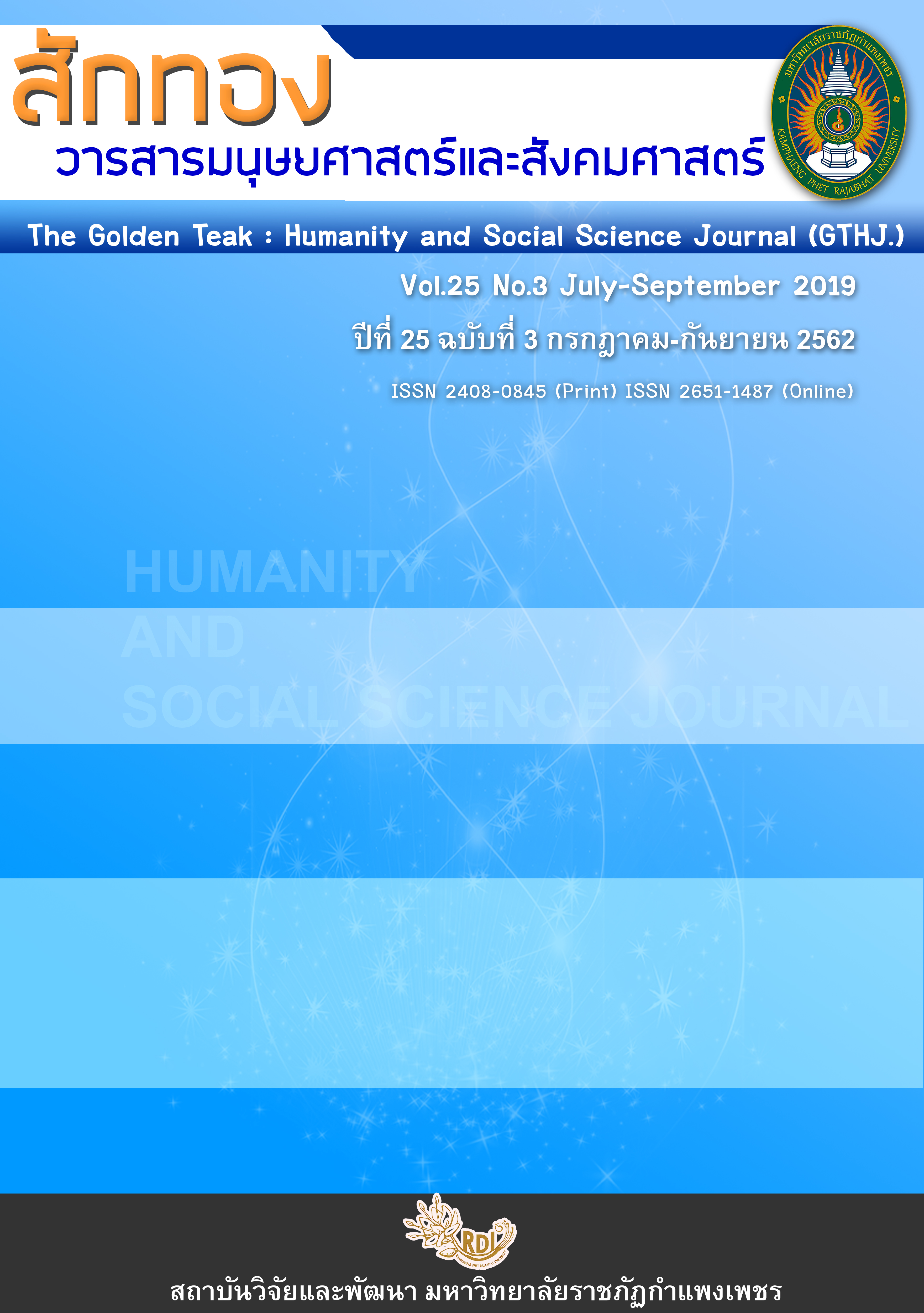The Continuance New Year tradition for Promoting Cultural Tourism of Thai Hill tribe Ethnic Groups Khlong Lan District in Kamphaeng Phet Province
Main Article Content
Abstract
The research aimed to study the continuance of New Year tradition for promoting cultural tourism on Thai hill tribe ethnic groups of Khlong Lan District in Kamphaeng Phet province. The key informants were six ethnic groups and government section. The research was a qualitative Study which used interpretation paradigm, using interview, focus group discussion, and participant observation. Data analysis and presentation of data based on ethnographic research. The results identified that New Year tradition of all hill tribe ethnic groups were; with the ethnic Hmong “Nor-Pejo” (น่อเป๊โจ่วฮ์) or “Kin-Samsip” (celebration on the New Year’s day) to hearten, respect to the ancestors, celebration, singing songs, local playing, sports competition, local sweet making competition, and throwing a ball for welcoming; with the ethnic Mien “Jia Xiang Hing” (เจี๋ย เซียง เหฮียง) on Chinese New Year, praying and blessing for the further year. Celebration by youth’s showing on stage, and Mien’s speech competition; with the ethnic Lisu “Kho-Oia” (โข่เซยี่ย) on Chinese New Year, respect their ancestors or worship ghost, merit making at the shrine, God’s blessing and elders, singing, playing music and Jakue dancing; with the ethnic Karen or called Pakakayor “Nee Sor Ko” (นี่ซอโค่) or the New Year in January after harvesting, eating new rice, doing heartening and wrist tying ceremony to their children, celebration, with the ethnic Lua, the tradition on Songkran festival just like Buddhism, merit making and watering to the alms elderly blessing, with the ethnic Lahu “Kor-Jao-Wae” (เขาะเ0จ๊0า0เ0ว0)0 0o0r0 0N0e0w0 0Y0e0a0r0 0o0f0 0e0a0t0i0n0g0 0n0e0w0 0r0i0c0e0 0i0n0 0D0e0c0e0m0b0e0r0 0t0o0 0g0i0v0e thanks to the God, Jakue dancing to respect the God, elderly blessing, joining Jakue dance, celebration, playing sports, archery or crossbow, running trestle, Saba, throwing gyroscopes, tug of war game, and putting water into the bamboo tubes game. Offered ways of continuation of traditional New Year in tourism of narration and then practicing, establishment of museum center, cultural activities, and exhibition of equipment for living us hill tribe cultural center. These led to the promotion and campaign ethnic annul to the youth’s awareness on the cultural value and improving the New Year’s tradition, Moreover, the tourism information should be created to the outside for welcoming on New Year’s tradition and promoting sustainable cultural tourism, and lastly, the culture and tradition should be kept, storing history and identities, both by the tourism management and by the communities and expression on the culture and tradition for accepting and understanding on the differences by the tourists.
Article Details
บทความที่ได้รับการตีพิมพ์เป็นลิขสิทธิ์ของวารสาร สักทอง : วารสารมนุษยศาสตร์และสังคมศาสตร์ สถาบันวิจัยและพัฒนา มหาวิทยาลับราชภัฏกำแพงเพชร
ข้อคิดเห็นใดๆ ที่ปรากฎในวารสารเป็นวรรณกรรมของผู้เขียนโดยเฉพาะ ซึ่งมหาวิทยาลัยราชภัฏกำแพงเพชรและบรรณาธิการไม่จำเป็นต้องเห็นด้วย
References
Borudieu, P. (1989). Social space and and symbolic power. Sociological Theory, 7(1), 14-25.
Charn-Arwut, C. (2017). the study of the identity’s value of street arts in order to create added value to inventive economy. Academic Journal: Humanities and Social Sciences, 25(49), 247-267.
Dutta, K. (2008). Convention on the elimination of all forms of racial discrimination (ICERD). Bangkok : Cross Cultural Foundation and Asian Human Right Institution.
Goset, S. (1962). Study on Tradition. Bangkok : Royal Academy.
Hawanon, N., et al. (2003). New Epistemology in Knowledge Construction for Strength of
Community and Society. Bangkok : Amarin Printing.
Jakae, O. (2017). Local Wisdom Knowledge Management Process of the Hill tribe Handicraft to creative Economy : Case study of Hmong and Mien Ethnic groups in Kamphaeng Phet Province. The Golden Teak : Humanity and Social Science Journal, 23(3), 52-70.
_______. (2017). Process of formal leadership and participation in local political approach of Thai Hill tribe Ethnic Group in Khlong Lan district, Kamphaeng Phet province. In the 6th National Public Administration Forum March 23 rd, 2018 (1-15). Bangkok : Public Administration Association of Thailand
_______. (2018). A Construction of Social Space to Get a New Way of Life Thai Hill Tribe Ethnic Groups in Kamphaeng Phet Province. Doctor of Philosophy Program in Human and Community Resource Development Kasetsart University.
Ketmanee, C. (2007). Cultural Diversity in Multicultural Society. Bangkok : National Research Council of Thailand.
Khampa K., et al. (2018). Heat Twelve Conservation for Community Empowerment.
Ratchapruek Journal, 16(1), 65-74.
Lee, C.K. & Back, K.J. (2003). Pre and post casino impact of residents perception. Annals of Tourism Research, 30, 868-885.
Maneerat, P. (1978). Social and Cultural Transformation. Bangkok : Thammasart University.
Ramitanont, C. (1993). Culture and Biological Diversity. Bangkok : Institute of Local Development.
¬Social Research, Institute. (2012). Management Manual on Community Tourism and Home Stay Accommodation. Chiang Mai : Chiang Mai University.
Triaganukul, L. (2009). The adaptation to Thai culture and the impact of rights limitations
To living qualities of Shan people from Chiang rai Province. Doctor of Philosophy Program in Social Science Ramkhamhaeng University.
Yiamchareon, T. (2010). The Study on Heat Khong Twelve Tradition in order to create
unity in Moo 12 Tambon Nakoo, Nakoo District, Kalasin. Bangkok : The Thailand
Research Fund.
Young, G. (1962). The Hill Tribes of Northern Thailand. Bangkok : Thai-American Audiovisual.


